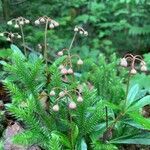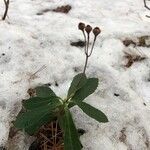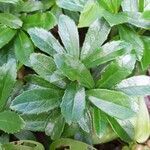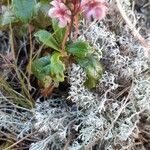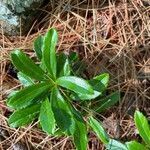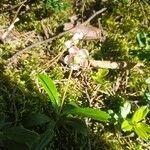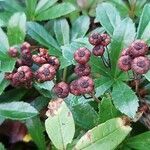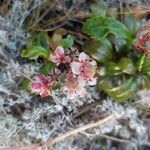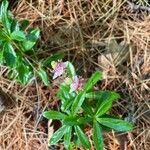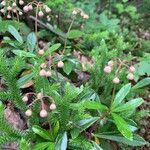Shrubs or herbs, to 15 cm tall, clonal, often forming extensive mats. Rhizome long creeping, 1–2 mm in diam., branched. Aerial stems erect or ascending, 1–2.2 mm in diam., simple or branched, angled, glabrous. Leaves cauline, in 2–6 subverticils of 4–9 each, alternating with caducous scales; petiole 3–6 mm, glabrous; leaf blade abaxially pale green, adaxially deep green, oblanceolate, 1–5 cm × 6–8 mm, thickly leathery, shiny, adaxially glabrous and with veins impressed, base cuneate, margin serrate above middle, apex obtuse to subacute. Peduncle erect, 3–6 cm, papillose, 2–7-flowered. Bract broadly linear, 3–4 mm. Sepals 5, persistent, ovate-orbicular, 1–2 × 1–2 mm, margin irregularly toothed, ciliate. Petals white, sometimes rosy, suborbicular, 4–6 × 3–5 mm, concave, margin irregularly toothed, opening fully. Stamens: lower dilated portion of filaments broadly ellipsoid, sparsely papillose; anthers 1.5–2.3 mm, papillate at base, tubes short, pores ca. 0.4 mm wide. Ovary longitudinally papillose, 5-loculed; stigma rounded, with 5 shallow lobes, 1.5–2.5 mm in diam. Capsules 4–7 mm in diam., fibers absent or oblong, 0.6–0.7 mm. Fl. Jul, fr. Sep–Oct. 2n = 26.
More
Stems spreading, the fertile branches erect, 1–3 dm; lvs oblanceolate, 3–6 cm, acute or mucronate, sharply toothed, especially above, nearly entire below, tapering to a short petiole; fls 4–8, corymbose or subumbellate, 10–15 mm wide; dilated part of the filaments ciliolate; 2n=26. Dry woods, especially in sandy soil. June–Aug. Circumboreal, with 2 vars. in Amer. Var. cisatlantica S. F. Blake (C. corymbosa), occurring from Que. and N.S. to Minn., s. to Va., W.Va., and n. Ind., has relatively thin, veiny lvs and mostly recurved pedicels. Var. occidentalis (Rydb.) S. F. Blake (C. occidentalis), from n. Mich. to B.C., s. to Colo. and Calif., has thicker, less veiny lvs and often ascending pedicels.
A shrub. It is evergreen. It often forms a mat. The underground stems or rhizomes are 1-2 mm across. They are long and creeping and branched. The aerial stems are erect or curve upwards. They are 5-15 cm long and 1-2.2 mm wide. They are angled. The leaves on the stem are in 2-6 groups of 4-9 leaves. The leaf stalk is 3-6 mm long. The leaf blade is pale green underneath. It is sword shaped and 1-5 cm long by 6-8 mm wide. It is thickly leathery. There are 2-7 flowers in a group 3-6 mm long. Often the flowers are nodding. The flowers are white. The fruit is a capsule 4-7 mm across. It splits open by 5 valves.
It is a temperate plant. It grows in dry pine and deciduous broad leafed forest at low altitudes in N China. It is best in light, well-drained soil. It needs a protected, shaded position. It is frost hardy. It suits hardiness zones 5-9.
More
Dry coniferous woods in Europe. Moist woods, particularly coniferous stands, and along mountain streams from the lower hills to about 2,500 metres in Western N. America.
